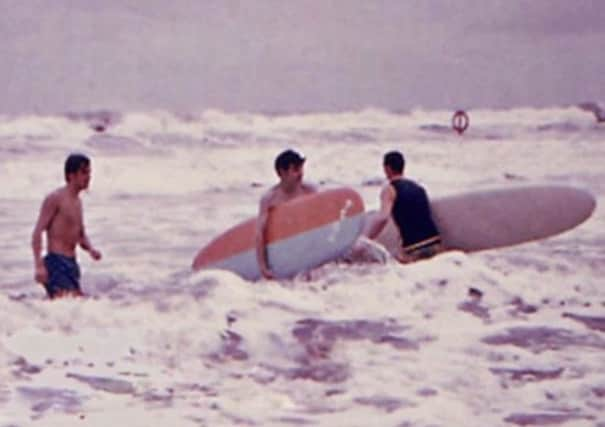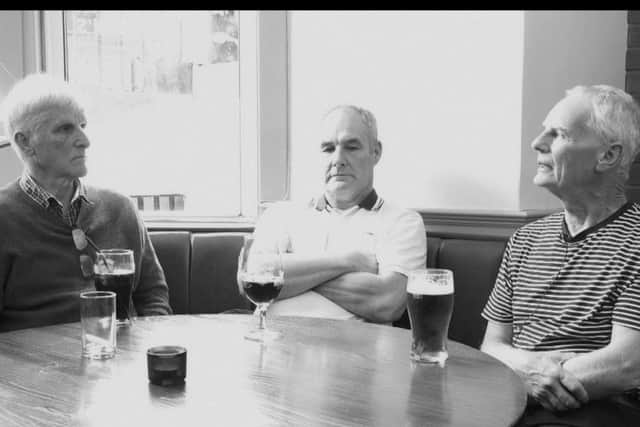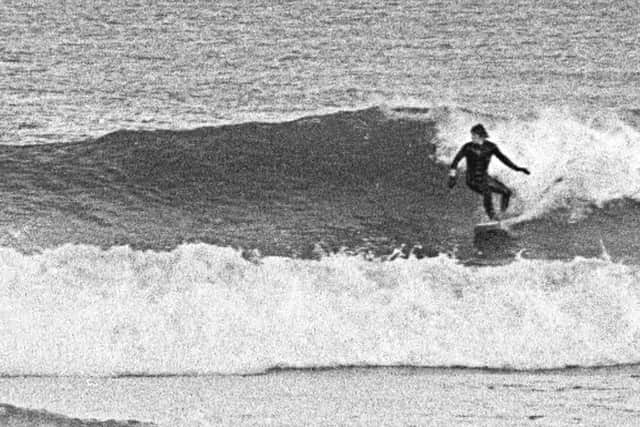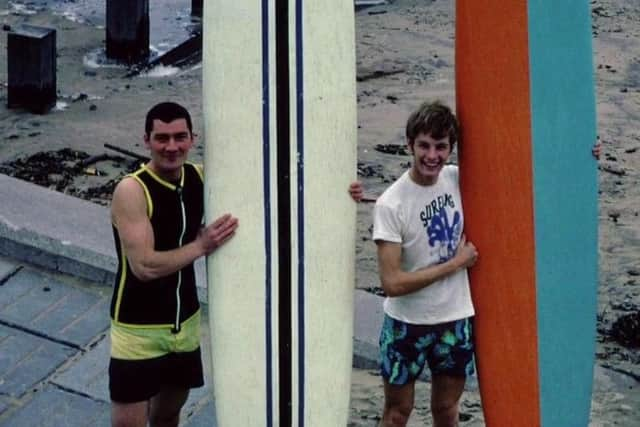Pioneers of Scottish surfing celebrate 50 years in the water


Pull up a surfboard and I’ll tell you a story about the early pioneers of the sport, Scotsman Magazine, 11 August 2018
Who was the first person to surf in Scotland? It’s a question that’s featured more than once in this column over the years, and one to which there is no easy answer. In 2006, when the British Surfing Museum brought an exhibition on the wave-riding history of these islands to Aberdeen, the official line was that the first person to catch a wave in Scottish waters and clamber to his feet was a Cornishman called Tris Cokes, who visited in 1968. (“Hey!” he said, when I asked him what his first Scottish surf was like, “I’m 56 years old! I’m supposed to remember what the day was like 40 years ago? It was bloody cold in the water, I remember that.”)
Advertisement
Hide AdAdvertisement
Hide AdSubsequent digging, however, revealed a hardy bunch of Aberdonian surfers headed up by Sandy Mathers, who had built and ridden hollow surfboards out of marine ply off the east coast well before Cokes. They in turn had been preceded by another Aberdeen local called George Law, whose early morning shifts at a nearby abattoir left him free to surf all afternoon from 1967 onwards.
Then, in 2014, not long after Law passed away, I was contacted by 91-year-old Neva Macdonald-Haig, who, along with her brothers Peter and David, rode waves off the Mull of Kintyre in the mid-1930s using rudimentary surfboards made for them by the local undertaker. (“It makes a good story to say they were coffin lids that we rode on,” she chuckled, “but they weren’t really. They were rounded at the end – probably about five or six-feet long.”) In one grainy image, Peter seems to be half-way to his feet – could he have been Scotland’s first ever surfer?
Clearly we’re still very much at the “first draft of history” stage with all this, but that just makes the stories of Scotland’s surfing pioneers all the more intriguing.
It’s hard to imagine from the vantage point of 2018, when every surfable wave in Scotland seems to be mobbed whenever there’s a decent swell running, but for a short time in the late 1960s there were little groups of surfers dotted around the country, happily surfing away by themselves and assuming that they were the only people riding waves anywhere north of Carlisle. In these very early days, whenever one of these tribes encountered another, it was a real “Dr Livingstone I presume” moment for all concerned – a rare coming-together of like-minded souls; a meeting of followers of the same religion, if you will, in an otherwise heathen society.
Andy Bennetts and his friends Ian Wishart and Stuart Chrichton may not have been the first people to surf in Scotland when they took a surfboard from Edinburgh to Aberdeen in September 1968 – although at the time they thought they might be. However, their pioneering journey was a significant moment in Scottish surfing history all the same – perhaps one of its defining moments – as it was probably the first time that two different groups of surfers from different parts of the country became aware of each other.


Bennetts and co, having lugged Bennetts’s heavy longboard all the way from the railway station to the beach, decided they needed somewhere to store it, so they asked an attendant at one of the pavilions where deckchairs were stored if they could leave it with him. “Of course,” came the reply, “put it in beside this other one.”
That “other” board turned out to belong to George Law. Bennetts and his friends soon met up with Law and, for a week in early September they all went surfing together in the waves off Aberdeen beach. None of them had wetsuits (although Law had a neoprene vest to keep out the cold) so nobody was able to stay in the water for very long at a time. When they got too cold to surf, they would retreat to the pavilion where the caretaker who had agreed to look after their surfboards would let them huddle around his wood-burning stove to warm up.
Bennetts, Wishart and Chrichton had their first Aberdeen surf on Monday 2 September 1968, so to mark the 50th anniversary of that red letter day Final Words thought it would be a good idea to sit down with Bennetts, Wishart and their friend Bill Batten, who was a key member of the Edinburgh surf scene of the late 60s, and talk about the early days. We ended up covering so much ground in our interview that it would have been impossible to do it all justice in a single column, so Andy, Ian and Bill’s stories will be appearing in instalments in this slot over the next couple of weeks – tune in next Saturday for Part One.
Advertisement
Hide AdAdvertisement
Hide AdHow a love of Americana and the Beach Boys helped launch surfing in Scotland, Scotsman Magazine, 18 August 2018


As outlined in last week’s column, 2 September will be the 50th anniversary of Scottish surfing’s big “Doctor Livingstone, I presume” moment – the day when surfers from Edinburgh first met up with surfers from Aberdeen, thereby forming the first known link between two of the nation’s early, geographically isolated wave-riding tribes and laying the groundwork for what would eventually become a distinctive national surfing culture, with its own legends, its own contests and its own “we-know-it’s-freezing-but-we-don’t-care” attitude. To mark the occasion, Final Words caught up with three veterans of those pioneering days – Andy Bennetts, Ian Wishart and Bill Batten – and for the next couple of weeks the best bits of our (long) conversation at Shackleton’s Bar in Edinburgh will be appearing here. Bennetts and Wishart were both on the much-discussed trip to Aberdeen in 1968, so they’ll be the focus of this week’s instalment; Batten subsequently had a Doctor Livingstone moment of his own – but we’ll get to that next week.
When they caught the train from Edinburgh to Aberdeen in early September 1968, teenagers Andy Bennetts, Ian Wishart and their friend Stuart Crichton were obsessed with Americana – as many people their age would have been one year on from the Summer of Love – and, armed with a surfboard owned by Bennetts, they also suspected that they might be the only surfers anywhere in Scotland.
“The surfing thing came about because Ian and I were both interested in cars and things American generally,” says Bennetts, “drag racing, the Beach Boys – all that kind of stuff. We were going to university and we had a short holiday between the end of school and the start of university and we thought, because I had bought a surfboard at that point, let’s go to Aberdeen, because I used to live there and I knew there were waves up there.
“The other chap was Stuart Crichton, who was also at school with us. We took my board which was a 9’6” pop-out [a factory-made surfboard] onto the train, got to Aberdeen, and then walked from the station carrying said board all the way to the beach, which was two miles maybe, something like that.”


“We got some funny looks,” remembers Wishart, “people wondering what it was. We walked right down Union Street, right down Beach Boulevard all the way to the Beach Pavilion, which is no longer there – it was knocked down many years ago.”
“We got to the beach fully expecting our surfboard to be the only one around,” says Bennetts, “and we thought ‘well, we’re not walking back and forth with this all the time so let’s try and find a place to store it.’ We asked the guy in charge of the pavilion if we could leave the board somewhere and he said ‘put it in beside this other one’ – at which point we were somewhat deflated, because George Law had been surfing there for a year before, and his board was kept permanently at the beach.”
Law, it turned out, had been surfing the waves off Aberdeen since 1967, his early shifts at a nearby slaughterhouse freeing him up to surf all afternoon. Bennetts and Co soon met up with him, and the four spent the next few days surfing together.
Advertisement
Hide AdAdvertisement
Hide Ad“Being poor prospective students,” says Bennetts, “we didn’t have the money to buy wetsuits, so it was on with the trunks and into the September Aberdeen sea.”
“It was very cold,” remembers Wishart, “but the caretaker of the pavilion was a nice chap who took pity on us because we were coming out frozen – he had a wee wood-burning stove and we sat around that.”
Bennetts picks up the story: “George Law just had a vest made of neoprene – he didn’t have a proper wetsuit – and he’d been surfing there right through the winter, which in Aberdeen is quite some feat.”
Law only stayed on in Aberdeen for a couple more years before emigrating to Canada. He passed away in 2014, but he certainly left an indelible mark on the sport, and not only because of his historic meeting with Bennetts, Wishart and Crichton. In 1968, California’s Surfer magazine, the “bible of the sport,” ran an article about Scottish surfing – perhaps the first ever – based on an interview with Law, which began with the immortal words: “Scotland??? Whoever heard of any surf in Scotland? Well, Scotsman George Law reports there’s fine surfing off Aberdeen beach in the chilly North Sea.”
Pease Bay, Dunbar and Coldingham – how the East Coast revealed its surfing potential, Scotsman Magazine, 25 August 2018
Welcome back to a comfortable corner of Shackleton’s Bar in Edinburgh, where Final Words is in the middle of interviewing three pioneers of Scottish surfing: Andy Bennetts, Ian Wishart and Bill Batten. Last week, you may remember, Andy and Ian were reminiscing about their groundbreaking 1968 trip from Edinburgh to Aberdeen with their friend Stuart Crichton – a budget, pre-university adventure with one surfboard between the three of them and (of course) no wetsuits. Thinking they might be the first people ever to surf in Scotland, the trio quickly realised they weren’t alone when they met up with Aberdonian surfer George Law, who had been surfing off Aberdeen Beach all by himself since 1967. It was still a momentous occasion for Scottish surfing, however, as it was almost certainly the first time that surfers from different parts of Scotland had met up and gone surfing together. Bennetts and Wishart have calculated that they first met Law on 2 September 1968, so Monday week could perhaps be said to be the 50th anniversary of the birth of Scotland’s surfing community – which is why this series of articles is appearing now.
Bennetts and Wishart had decided to try surfing in Aberdeen because Bennetts had lived there for a time, so he knew there would be waves. However, once they were back in Edinburgh it didn’t take them long to figure out that there were also plenty of places to surf closer to home, first in East Lothian and then further down the A1 – and before long, the surfing tribe of south-east Scotland started to attract new members.
“There were a few people [in Edinburgh] by this time with surfboards,” says Bennetts, “and one of them was a guy called Pete Rennie. Pete didn’t have a driving licence but his father was very sympathetic so he would give Pete and his board and me and my board a lift down to the beach. We were looking at Dunbar, Belhaven, round about that area. One day we were going to the beach and this van was coming up the other way with a board on the top. So we screeched to a halt, and it turned out to be Bill [Batten]. This was quite near Belhaven Bay. We asked him ‘where did you get that?’ and he said, ‘Oh, New Zealand.’”
Advertisement
Hide AdAdvertisement
Hide Ad“I’d surfed down the East Coast for a wee while before I met Andy and Ian,” says Batten. “My first time surfing in Scotland was December 1967. I was more or less there by accident. I’d lived in New Zealand, then Australia, and then I’d shipped a surfboard back. When it arrived somebody said to me ‘Why don’t you go to Pease Bay? I believe there are waves there.’ I said ‘That can’t be possible,’ but I did go down, and the waves were reasonably big. The water was quite cold though, so I didn’t stay in too long. I didn’t have a wetsuit then, so it was shorts and in. Freeze, then get out quick.”
Unsurprisingly, Batten was inspired to get a wetsuit fairly soon after this first, bone-chilling experience.
“In 1968 I found a company [in Newquay] that sold neoprene rubber with drawings of how to cut out a wetsuit,” he says. “It was more or less a diving wetsuit though, with a big flap at the front with buttons, and they sent you this neoprene and a plan and a tin of glue. So my wife and I spent a week cutting all this out and sticking it all together and that was my first wetsuit. Extremely uncomfortable but it was warmer than not having a wetsuit.”
As they started exploring further afield, the crew soon found that there were surf spots dotted all along the coast south of Dunbar. Bennetts picks up the story: “We soon realised that Pease Bay had better waves than Belhaven – once you got your head around surfing over the rocks.”
“And Coldingham was almost a kind of a last resort,” adds Wishart. “If Pease was closing out [too big to surf] then you could still get in at Coldingham, but Coldingham was a funny kind of break – it used to break right across the whole beach rather than giving you a decent ride.”
“You have to bear in mind that there weren’t any decent weather forecasts,” says Bennetts. “There certainly wasn’t a swell forecast, so you went down on the basis of ‘It’s Saturday, let’s go down the beach.’”
For all that Bennetts and Co pioneered many of the best-known spots in south-east Scotland, there were so few surfers in those days that once they’d found a few good ones there wasn’t much incentive to keep looking. “There were only ten or 12 people total, so there wasn’t the pressure to go and find somewhere else,” says Bennetts.
However, as we’ll discover next week, a significant surfing discovery was just around the corner.
Advertisement
Hide AdAdvertisement
Hide AdThose who mapped Scotland’s great surfing spots, we salute you, Scotsman Magazine, 1 September 2018
Tomorrow, Sunday 2 September, will be the 50th anniversary of one of the key moments in Scottish surfing history – the day when three Edinburgh surfers, Andy Bennetts, Ian Wishart and Stuart Chrichton met up with Aberdonian surfer George Law on Aberdeen Beach, thereby establishing that they were not the only surfers in the country (as they’d previously assumed) and laying the groundwork for what would eventually become the distinctive Scottish surf scene we have today.
To mark the occasion, Final Words met up with Bennetts, Wishart and their friend Bill Batten, another pioneering Scottish surfer, and asked them to share some of their memories of the good old days – days when the waves were empty, the boards were long and the wetsuits were either homemade or non-existent. Last week and the week before we dealt with the crew’s discoveries in South-east Scotland and the famous trip to Aberdeen in 1968; this week we look at what came next – the gradual realisation that there were great surf spots to be found all around the country, just waiting for somebody to come along and surf them for the first time.
In the early days, Bennetts points out, there wasn’t much incentive to go looking for waves beyond the breaks of East Lothian and the Borders. Once they’d found spots like Belhaven, Pease Bay and Coldingham – all within easy striking distance of Edinburgh and with nobody else around to surf them – there wasn’t much point wasting valuable water time searching elsewhere. That said, they did occasionally try surfing in different places just for the hell of it. Batten remembers one session at Dunbar that got him into trouble with the law.
“I surfed off the rocks at Dunbar once,” he remembers, “where the harbour is – in the town itself. That wasn’t a great idea because the police pulled me in and said ‘What are you doing? We were about to send the lifeboat out for you!’
“I thought ‘The lifeboat would probably have been wrecked, but I’d have been alright.’”
No matter how good the waves on the east coast were, however, it was only ever going to be a matter of time before Scotland’s surfers started looking west, to the powerful waves of the Atlantic. Travel times and costs being what they were in the late 1960s and early 1970s, the islands were a tricky proposition, but Machrihanish, on the swell-exposed southern tip of the Mull of Kintyre, was a little more accessible (although only a little), so it seemed like an obvious place to try.
Although it can have great waves in certain conditions, Machrihanish and the spots nearby have a fairly narrow swell window so they can be maddeningly inconsistent, and in the days before accurate surf forecasts this made a trip there even more of a gamble than it is today. “Machrihanish is relatively sheltered,” says Bennetts, “so you didn’t really know when you set off whether there were going to be waves until you got there.”
Advertisement
Hide AdAdvertisement
Hide AdThe next major discovery was just around the corner, however, and it was Batten who made it, stumbling upon the untapped surfing potential of Scotland’s north coast completely by accident.
“I went to a wedding up there in about 1970,” he says, “to a place called Bettyhill. I looked out of the window in the morning and these waves were rolling in and I thought ‘Oh wow, this is the place to be!’ I didn’t have a board with me of course, but I did have a trip up there very quickly after that and that got the north shore going.”
The now-famous barrels peeling along the reef at Thurso East weren’t surfed until the mid-1970s, and they didn’t really appear on the surfing world’s radar until 1978, when Liverpudlian transplant Pat Kieran finally got lonely surfing them all by himself and wrote an article for an English surfing magazine appealing for people to come and join him.
In the early 70s, however, before Thurso became synonymous with surf, Batten, Bennetts, Wishart and Co found plenty of other great spots to keep them entertained around Bettyhill.
“Bettyhill was good because there was a choice of waves up there,” says Bennetts. “You had Torrisdale, Farr Bay, Strathy... and nobody else had ever been up there [to surf] as far as we knew.
“The thing I remember about going up to Bettyhill was the drive,” he continues. “You used to leave work [in Edinburgh] at four o’clock on Friday night and you drove for hours and hours and you got to Bettyhill at half-past eleven, because there was no Kessock Bridge, it was the Kessock Ferry, and there was no Cromarty Bridge either. We took the single track road for the last bit from Helmsdale, by which time it was usually getting dark. So there would be three or four cars charging up this single track road, being aware of sheep...”
And that seems like as good a place as any to leave our three surfing pioneers, driving north through the lonely countryside of Sutherland as night falls, a little string of tail-lights following the winding course of the River Halladale towards the sea, and the promise of waves in the morning.
Surfing, it is often said, is a sport that leaves no trace, but everyone who has surfed in Scottish waters since Bennetts, Batten and Wishart has been following in their footsteps, whether they realised it or not.